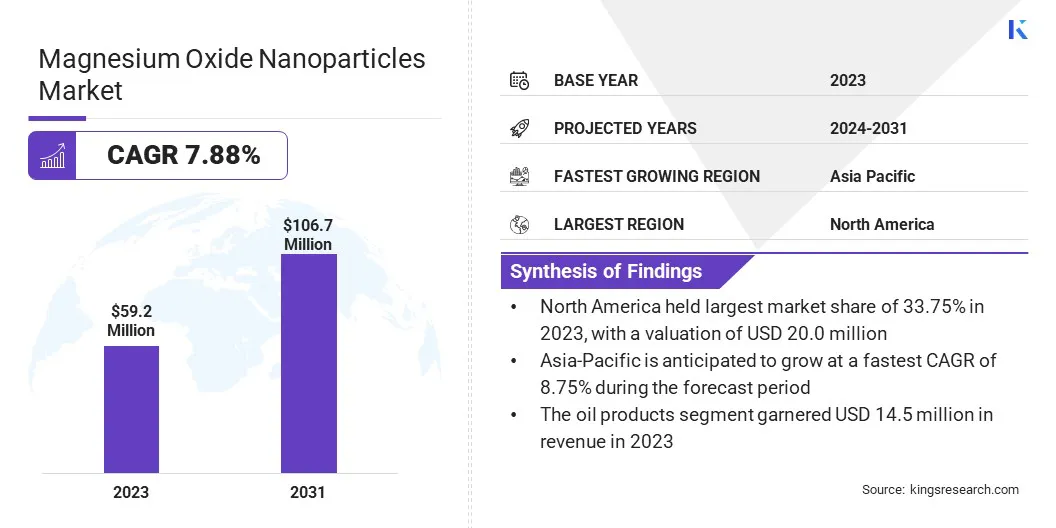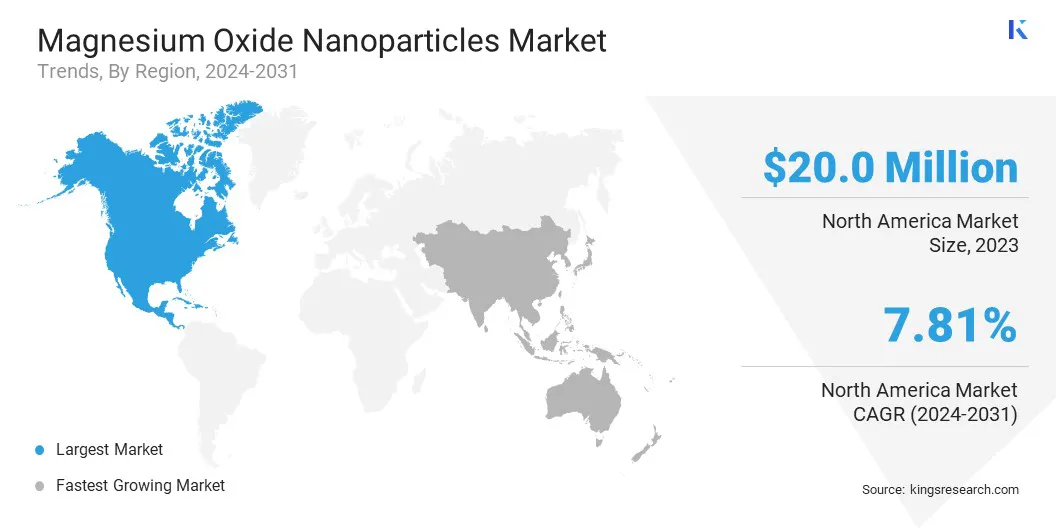Market Definition
The market involves the production, distribution, and commercialization of nanoparticles made from magnesium oxide (MgO). These nanoparticles are characterized by their small size, high surface area, and unique properties, which make them useful in a variety of applications.
Magnesium oxide nanoparticles are widely used in pharmaceuticals, materials sciences, electronics, environmental remediation, and energy storage applications.
Magnesium Oxide Nanoparticles Market Overview
The global magnesium oxide nanoparticles market size was valued at USD 59.2 million in 2023 and is projected to grow from USD 62.8 million in 2024 to USD 106.7 million by 2031, exhibiting a CAGR of 7.88% during the forecast period.
This market is registering significant growth, due to the rising adoption of magnesium oxide nanoparticles in wastewater treatment, flame retardants, fuel additives, and antimicrobial coatings.
Major companies operating in the magnesium oxide nanoparticles industry are Umicore, Merck KGaA, American Elements, AdNano Technologies Pvt Ltd, Inframat Advanced MaterialsTM, LLC, Techinstro, Nanoshel LLC, Lorad Chemical Corporation, SkySpring Nanomaterials, Inc., Reinste Nano Ventures Pvt. Ltd., Strem Chemicals, Inc., EPRUI Biotech Co., Ltd., US Research Nanomaterials, Inc., Nanostructured & Amorphous Materials, Inc., and Nanografi Nano Technology.
Ongoing research and development efforts to enhance the functional properties of these nanoparticles are expected to create new opportunities for market players. Furthermore, strategic collaborations, technological advancements, and growing government support for nanomaterial research are expected to further propel the market's growth in the coming years.
- In August 2024, Springer Nature Limited published a study on the green synthesis of magnesium oxide nanoparticles (MgO NPs) using Hyphaene thebaica fruit extract. The research explores an eco-friendly approach to producing MgO NPs, which were found to be quasi-spherical with sizes ranging from 20 to 60 nm. These nanoparticles exhibited an impressive 98% degradation efficiency of methylene blue dye under visible light within 110 minutes, demonstrating their strong potential for environmental remediation applications.

Key Highlights
- The magnesium oxide nanoparticles industry size was recorded at USD 59.2 million in 2023.
- The market is projected to grow at a CAGR of 7.88% from 2024 to 2031.
- North America held a market share of 33.75% in 2023, with a valuation of USD 20.0 million.
- The oil products segment garnered USD 14.5 million in revenue in 2023.
- The market in Asia Pacific is anticipated to grow at a CAGR of 8.75% during the forecast period.
Market Driver
"Increasing Use in Flame Retardants and Coatings"
Magnesium oxide nanoparticles areused in flame retardants and protective coatings due to their high thermal stability, non-toxicity, and fire-resistant properties. They act as effective additives in polymers, paints, and textiles, forming a protective barrier to reduce flammability.
Widely applied in construction, automotive, and aerospace industries, they also enhance durability, corrosion resistance, and thermal insulation. With more stringent regulations on fire safety and a shift toward eco-friendly alternatives, the demand for MgO nanoparticles in flame-retardant applications continues to rise. They also replace traditional halogen-based retardants. This makes them a greener option for safer and more effective fire protection.
Market Challenge
"Inconsistent Manufacturing Standards"
The lack of standardized manufacturing processes in the magnesium oxide nanoparticles market leads to variations in quality, purity, and performance, impacting product reliability across industries.
Difference in particle size, composition, and surface area can impact product efficacy of pharmaceuticals, electronics, and flame retardants. This inconsistency poses regulatory challenges and hinders market adoption.
To address this challenge, production techniques can be standardized to ensures uniformity in particle size, purity, and composition. Industry regulations and certifications can set clear quality benchmarks, while advanced quality control methods, like real-time monitoring and AI-driven analytics, improve consistency.
Collaboration and knowledge sharing promote best practices, and ongoing R&D investments enhance efficiency, optimization, and reliability, boosting market confidence and adoption.
Market Trend
"Rising Demand in Healthcare and Pharmaceuticals"
The rising demand for magnesium oxide nanoparticles in healthcare and pharmaceuticals is fueled by their antimicrobial, biocompatible, and pH-regulating properties. They are widely used in drug delivery, wound healing, and antimicrobial coatings for enhancing treatment effectiveness.
Additionally, their role in acid reflux medications, controlled drug release, and cancer therapy is expanding. With increasing concerns over antibiotic resistance and advanced healthcare materials, MgO nanoparticles are becoming essential in pharmaceutical applications.
- In May 2024, the National Library of Medicine published a study on magnesium-magnesium oxide (Mg-MgO) nanoparticle composites for orthopedic applications. The research highlights how MgO nanoparticles enhance biocompatibility, biodegradability, bioactivity, and antibacterial properties, addressing magnesium’s rapid degradation and biofilm formation. The study reviews the mechanical, corrosion, and biological performance of these composites in orthopedic implants.
Magnesium Oxide Nanoparticles Market Report Snapshot
|
Segmentation
|
Details
|
|
By Application
|
Oil Products, Coatings, Construction & Ceramics, Advanced Electronics, Aerospace, Refractories, Others
|
|
By Region
|
North America: U.S., Canada, Mexico
|
|
Europe: France, UK, Spain, Germany, Italy, Russia, Rest of Europe
|
|
Asia-Pacific: China, Japan, India, Australia, ASEAN, South Korea, Rest of Asia-Pacific
|
|
Middle East & Africa: Turkey, UAE, Saudi Arabia, South Africa, Rest of Middle East & Africa
|
|
South America: Brazil, Argentina, Rest of South America
|
Market Segmentation
- By Application (Oil Products, Coatings, Construction & Ceramics, Advanced Electronics, Aerospace, Refractories, Others): The oil products segment earned USD 14.5 million in 2023 due to the increasing use of magnesium oxide nanoparticles in fuel additives, and desulfurization processes to enhance efficiency and performance.
Magnesium Oxide Nanoparticles Market Regional Analysis
Based on region, the market has been classified into North America, Europe, Asia Pacific, the Middle East & Africa, and Latin America.

North America magnesium oxide nanoparticles market share stood at around 33.75% in 2023 in the global market, with a valuation of USD 20.0 million. This expansion is facilitated by its strong demand in pharmaceuticals, electronics, and environmental applications.
The region benefits from advanced R&D activities, well-established nanotechnology industries, and stringent environmental regulations, fueling the adoption of MgO nanoparticles in coatings, flame retardants, and healthcare applications.
Furthermore, the increasing focus on eco-friendly materials has boosted the adoption of MgO nanoparticles in wastewater treatment and air purification technologies. Regional growth is also driven by the presence of key market players, leading research institutions, and strong government support for nanotechnology advancements.
The Asia-Pacific magnesium oxide nanoparticles industry is expected to register the fastest CAGR of 8.75% over the forecast period. This growth is fueled by rapid industrialization, expanding electronics and construction sectors, and increasing demand for advanced materials.
China, India, Japan, and South Korea lead the market with extensive investments in nanotechnology, strong manufacturing infrastructure, and increasing applications in pharmaceuticals, coatings, and refractories.
Moreover, supportive government policies, expanding research initiatives, and growing demand for sustainable, high-performance materials are accelerating market expansion.
Regulatory Frameworks
- The U.S. Environmental Protection Agency (EPA) enforces the Toxic Substances Control Act (TSCA), which regulates the manufacture, processing, distribution, and disposal of chemical substances to prevent unreasonable risks to human health and the environment.
- The International Organization for Standardization (ISO) implements ISO/TR 13121:2011, which provides a framework for the risk evaluation of nanomaterials, ensuring their safe use and management while minimizing potential risks to consumers, workers, and the environment.
- The European Chemicals Agency (ECHA) enforces the REACH (Registration, Evaluation, Authorization, and Restriction of Chemicals) Regulation, which mandates the registration, risk assessment, and safe handling of chemical substances, to protect human health and the environment while promoting innovation and competitiveness in the chemicals industry.
- In Japan, the Ministry of Economy, Trade, and Industry (METI) enforces the Chemical Substances Control Law (CSCL), which regulates the manufacture, import, and use of chemical substances, including magnesium oxide nanoparticles, to prevent environmental pollution and ensure chemical safety through risk assessment and reporting requirements.
Competitive Landscape
The magnesium oxide nanoparticles industry is characterized by intense competition, with companies focusing on cost-effective manufacturing, product differentiation, and expanding their distribution networks.
The market is witnessing increasing investments in large-scale production facilities to cater to the rising demand across diverse industries. Key players are also emphasizing customized solutions tailored to specific applications such as electronics, energy storage, and catalysis, driving innovation in nanoparticle formulations.
With the growing adoption of nanomaterials, businesses are continuously refining their supply chain strategies, enhancing quality control measures, and maintaining compliance with evolving regulatory standards to achieve a competitive edge in the market.
List of Key Companies in Magnesium Oxide Nanoparticles Market:
- Umicore
- Merck KGaA
- American Elements.
- AdNano Technologies Pvt Ltd,
- Inframat Advanced MaterialsTM, LLC
- Techinstro
- Nanoshel LLC
- Lorad Chemical Corporation
- SkySpring Nanomaterials, Inc.
- Reinste Nano Ventures Pvt. Ltd.
- Strem Chemicals, Inc.
- EPRUI Biotech Co.,Ltd.
- US Research Nanomaterials, Inc.
- Nanostructured & Amorphous Materials, Inc.
- Nanografi Nano Technology.


